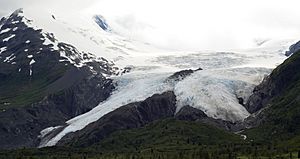Worthington Glacier facts for kids
Quick facts for kids Worthington Glacier |
|
|---|---|
| Type | Valley |
| Location | Alaska |
| Coordinates | 61°10′13″N 145°45′48″W / 61.17028°N 145.76333°W |
| Area | 5,774 acres (2,337 ha) |
| Status | Receding |
| Designated: | 1968 |
The Worthington Glacier is a huge river of ice located in Alaska, USA. It covers about 5,774-acre (2,337 ha) of land. This amazing glacier sits right next to Thompson Pass in the southeastern part of Alaska. It is easy to visit because it is found along the Richardson Highway, about 28.7 mi (46 km) east of Valdez.
Worthington Glacier is very special because it was named a National Natural Landmark in 1968. This means it is an important natural place that needs to be protected. It is also one of the few glaciers in the United States that you can easily reach by a paved road.
Contents
What is a Glacier?
A glacier is a very large, slow-moving mass of ice. It forms over many years from layers of snow that get packed down. When enough snow builds up, it turns into ice. Then, gravity slowly pulls this ice downhill.
Types of Glaciers
There are different kinds of glaciers. Worthington Glacier is a valley glacier. This type of glacier flows through valleys, just like a river. They often carve out U-shaped valleys as they move.
Visiting Worthington Glacier
You can get a great view of Worthington Glacier at the Worthington Glacier State Recreation Site. This is a park operated by the state of Alaska. It covers about 113-acre (0.46 km2) and is right by the road.
What to See and Do
At the recreation site, you can enjoy amazing views of the glacier. There are also places to learn more about glaciers and the nature around them. It is a popular spot for people who want to see a real glacier up close.
Glacier Changes Over Time
Like many glaciers in Alaska, Worthington Glacier has been getting smaller. This process is called receding. It means the end of the glacier is slowly moving backward.
Why Glaciers Recede
Glaciers recede when more ice melts away than new snow falls and turns into ice. Over the last 150 years, many glaciers in Alaska have been receding. Worthington Glacier has also been getting smaller, but not as fast as some others. Scientists study glaciers like Worthington to understand how Earth's climate is changing.


